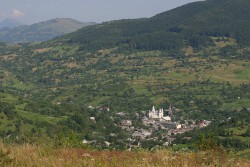Valuing benefits
Many elements of wilderness and wild lands, including their intrinsic spiritual, landscape and biodiversity values, are literally priceless.
The quantification approach is thus intended to supplement and not supplant traditional approaches to assessment of wildland.
However it is increasingly feasible and indeed important to quantify the benefits of wilderness, wildlands and large natural habitat areas, both in monetary terms and for wider societal gain.
Why valuation?
 Sheep, conifers, wind farms or wild areas? Relative valuations are one way of determining
Sheep, conifers, wind farms or wild areas? Relative valuations are one way of determiningIt is important to quantify the benefits of wild areas:
- To provide cost:benefit based argument against threats and alternative land uses
- In support of funding requests for protection or restoration projects
- To inform policy decisions, particularly in competition with other sectors
Valuation of wild areas helps articulate their importance to key decision takers, whether local landholders or national politicians who tend to be predominantly urban.
It can also help underwrite wider support among media and the general public, with wilderness increasingly seen as an integral part of modern society.
Quantifying the benefits
1. Direct benefit valuation
- Income flows, cost savings, employment creation
- Additional benefits from ancillary activities (accommodation and branding opportunities, possible increases in land values. Assess the multiplier effect.
- Use sensitivity analysis to factor in alternative assumptions about subsidy levels, income and employment potential from benefits etc.
2. Indirect benefit valuation
- Environmental benefits – eg flood mitigation: examples of savings in downstream capital expenditure, running costs and insurance claims as the result of natural habitat restoration in catchment areas and lowland flood sinks reducing run-off variability or pollution.
- Social benefits of wild areas: eg youth at risk – costs saved through reduced re-offence rates or non-custodial sentencing; remedial or palliative healthcare – eg less working days lost from stress or; shorter and thus cheaper psychotherapy courses
3. Opportunity for use of Contingent Valuation and Willingness to Pay (WTP)
 Communities can benefit for multiple wild area benefits, but their value is seldom quantified – Maramures in Romania. – Frans Schepers
Communities can benefit for multiple wild area benefits, but their value is seldom quantified – Maramures in Romania. – Frans SchepersThese econometric methods can help quantify the worth of landscape and species conservation through assessments the values ascribed to these by consumers, taxpayers and general public.
Contingent Valuation represents the value of a particular measure – for example how much of the last 5% of their Income Tax would a tax payer like to see spent on restoring a wetland containing beaver, as against a marginal increase in housing subsidy or road building.
Willingness to Pay measures how much a consumer would contribute towards a particular experience – eg visiting a wild area; this can then be aggregated to calculate its consumption value.
4. Review the overall cost-benefit of protection or restoration
There are three steps in this process:
- Assessment of the aggregate “net value” of a particular protection or restoration measure. Take into account income and employment created on the one hand, and costs on the other: including direct land cost, the loss of alternative land use (‘opportunity cost’ in economist’s parlance) and any costs associated with restoration (through natural and assisted regeneration) or protection. Measures of Contingent Valuation and Willingness to Pay can also be used here.
- Comparison of cost:benefit – as against alternative land uses: eg logging or agricultural use. There is a need to take account of trends in subsidies – eg the future impact of Common Agricultural Reform reforms – and of farm and timber prices
- Draw conclusions on the quantifiable rationale for protecting or restoring a wild area. These should be run alongside aesthetic, biodiversity and other arguments
